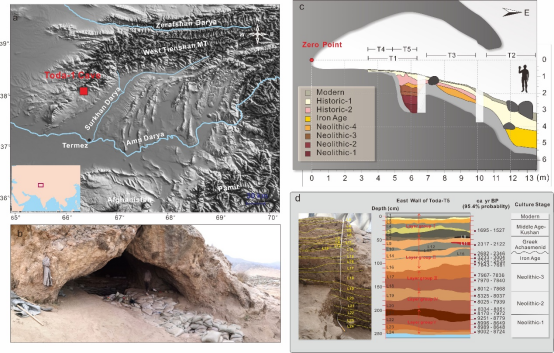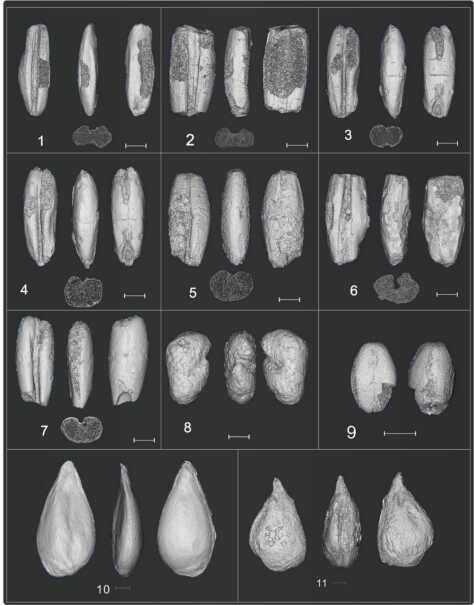Quasi-Agricultural Practices of the Pre-Pottery Neolithic Culture in Central Asia (Approximately 9000 BP) — Harvesting and Consuming Barley
The Neolithic Revolution was a pivotal event in human evolutionary history. The gathering and domestication of cereal grains, such as wheat and barley, around 10,000 years ago in the Fertile Crescent of West Asia was crucial to the rise of agricultural societies and laid the material foundation for the emergence of civilizations in Mesopotamia and ancient Egypt. However, whether other groups in the vast grasslands of Asia beyond the Fertile Crescent also attempted and successfully domesticated Triticeae grasses is a question central to existing theories on agricultural origins and remains a crucial topic of debate in archaeological circles.

Figure 1. Location of Toda No.1 Cave in Uzbekistan, stratigraphic distribution, entrance photo and chronological stratigraphy
On August 25, an international research team composed of the Institute of Vertebrate Paleontology and Paleoanthropology (Chinese Academy of Sciences), Northwest University, the Archaeological Institute of Cultural Relics of Uzbekistan (Samarkand), and the Max Planck Institute for Geoanthropology (Germany), among others, published a paper in the Proceedings of the National Academy of Sciences (PNAS) reporting the latest research findings from Toda Cave 1 in the Surkhan Valley of southern Uzbekistan. The study reveals evidence of agricultural-like practices—harvesting and consuming barley—in a pre-pottery Neolithic culture (ca. 9000 cal yr BP) in Central Asia.
Located in the heart of Eurasia, Central Asia connects East and West Asia, as well as South and North Asia, serving as a crossroads for ancient human and cultural exchanges. Research on the origins of early agriculture and pastoralism in this region has long been scarce, making it a "missing link" in the story of agricultural origins and dispersal. In recent years, the joint research team conducted field surveys in the piedmont regions of southern Uzbekistan, discovered Toda-1 Cave, and after three excavation seasons (2017–2019), uncovered cultural layers from the early Neolithic period.
Through systematic archaeobotanical studies, the team discovered barley, pulses, and a variety of other plant seeds and fruits dating to the pre-pottery Neolithic period in Central Asia. The oldest barley seeds were dated to 9133–8970 cal yr BP, demonstrating that barley gathering had become an important subsistence practice in the piedmont zones of Central Asia by at least 9,000 years ago and continued for millennia. The barley grains include both hulled and naked varieties, and based on key morphological characteristics (such as the thickness-width ratio), they fall within the range of wild cereals and are classified as wild barley. However, nearly half were naked barley, a proportion significantly higher than that found at contemporary early agricultural sites in the Near East, possibly indicating a distinct evolutionary trajectory.

Figure 2. Charred seeds unearthed from Toda-1 Cave
Some microliths recovered from the same layer exhibit typical "sickle gloss" on their surfaces, indicating that these stone blades were used as inserts in sickles for harvesting cereals. The site also yielded several grinding stones with traces of cereal and pulse processing, which together with the blades illustrate the complete operational sequence from harvesting to milling. Furthermore, finds of pistachio shells and wild apple seeds at Toda Cave 1 reflect the broad exploitation of plant resources by early Neolithic populations.
Palynological and organic isotopic studies indicate that the vegetation in the region 9,000 years ago included extensive tree cover and a high proportion of C4 plants, suggesting a climate significantly different from today’s. An intensified South Asian monsoon likely contributed substantially to regional precipitation and facilitated the development of pre-pottery Neolithic cultures and the emergence of cereal gathering practices in the piedmont regions of Central Asia.
As a representative example of Sino-foreign collaboration in archaeology and paleoanthropology, this study pushes back the history of cereal use in Uzbekistan by nearly 4,000 years. It provides key data for understanding the cultural typology and economic model of pre-pottery Neolithic cultures in Central Asia and lays an important foundation for further discussions on the origins and exchange of agriculture in inland Asia.
This research was supported by the National Key R&D Program of China (2022YFF0801102, 2022YFE0203800), Chinese Academy of Sciences Project for Young Scientists in Basic Research (YSBR-019), and the European Research Council (FEDD, Grant Number 851102).
Download attachments: